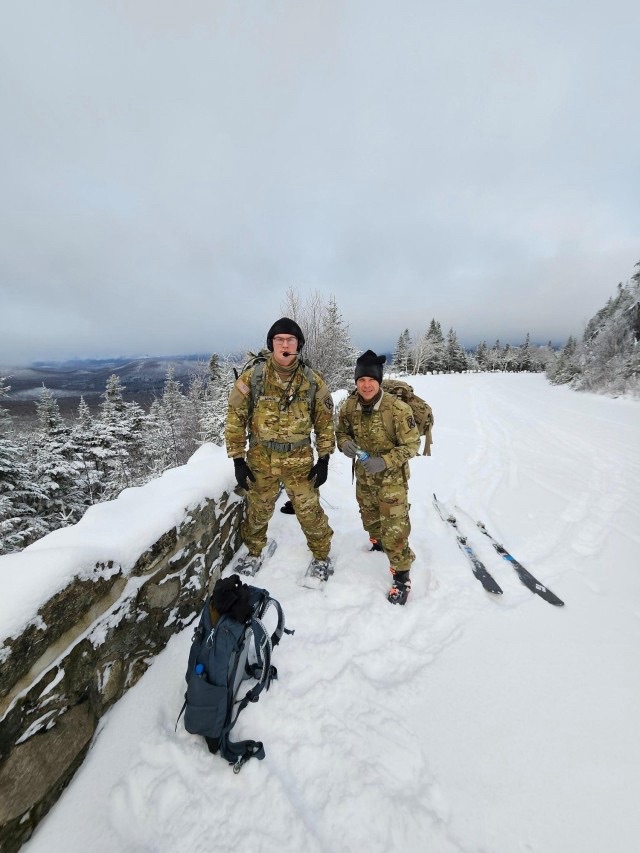
FORT DRUM, N.Y. (Dec. 7, 2023) – In a poignant echo of the 10th Mountain Division’s historic roots, two seasoned warriors shaped by the division’s legacy embarked on a perilous ascent of Whiteface Mountain, towering at an elevation of 4,867 feet.
Rooted in a tradition forged during World War II, where the division played a pivotal role in the Italian Alps, these Soldiers drew inspiration from their predecessors who braved the harsh terrain to dislodge German forces.
Tasked with a mission crucial for Hunter EMS VIIb, an exercise where Soldiers from the 10th Mountain Division Artillery (DIVARTY) executed electronic warfare tactics, Lt. Col. Gregory Eldridge, 10th Mountain Division deputy fire support coordinator, and Staff Sgt. Alex Miner, a fire direction noncommissioned officer from DIVARTY’s Fire Control Element, faced a race against time.
“We’re trying to see what electronic warfare assets can do against our systems so we can defeat it in the future,” Eldridge explained.
The exercise, held on Fort Drum and Ethan Allen, Vermont, from Nov. 30 to Dec. 5, aimed to validate and improve the division’s operational capacity in an ever-evolving battlefield by combining kinetic and non-kinetic effects.
“In addition to the electronic warfare, we conducted some training with radars,” Eldridge added. “We did a lot of work with the extension of line-of-sight communications.”
The previous day’s efforts to drive up the access road to Whiteface summit were thwarted by a snowed-in road and gate. This obstacle hindered industry partners from installing a directional antenna atop the mountain, vital for completing a line-of-sight linkage between Fort Drum and Ethan Allen.
“At the end of the day, we needed to get that antenna up to the top of that mountain,” Eldridge said. “I knew that there was a route to get there, and I had the equipment to get there. I just wanted to ensure that we had exhausted every means possible to extend the line of sight as far as possible.”
The two Soldiers ascended Whiteface on Dec. 5, the last day to attempt establishing communications between Fort Drum and Ethan Allen; it was all or nothing.
“To say Lt. Col. Eldridge and Staff Sgt. Miner’s efforts were crucial to the successes in extending line-of-sight communications during Hunter EMS VIIb is an understatement,” said Maj. Mark Smerka, DIVARTY fire support officer.
This was the unit’s last chance to attempt closing the communications link between Fort Drum and Ethan Allen before industry partners would have to depart for other obligations.
“If it weren’t for Lt. Col. Eldridge and Staff Sgt. Miner’s commitment to the challenge before them, we could only establish communications at approximately half the distance we did achieve,” Smerka added.
With the technical analysis underscoring the peak’s critical role in closing the communication link east of New York state, Eldridge and Miner volunteered for the challenging task.
“It takes specialized equipment to get there,” Eldridge explained. “I just wanted to get the job done.”
In less than 10 hours, they prepared for the cold trek, driving two hours from Ethan Allen, where they were supporting Hunter EMS VII, to commence their ascent at first light.
Their journey, spanning five miles, mirrored the division’s historical feats in the Italian Alps.
“I don’t know if it necessarily impacted my decision to volunteer to do it,” Eldridge said. “But you certainly think about it when you’re feeling sorry for yourself on the five-mile trip up, knowing full well that our forefathers went a lot further and were getting shot at.”
Battling a minus-2-degree wind chill, the trio, including industry partner Pat Murray, reached the summit. Despite the adversity, the two Soldiers, drawing on the division’s mountain warfare training, successfully installed communication gear at the observatory.
As they conducted troubleshooting efforts in conditions reminiscent of the division’s past battles, the communication link between Fort Drum and Ethan Allen proved elusive. Within 45 minutes, the weather turned on them.
“At first, it wasn’t too bad, and we didn’t have to troubleshoot too much. We just had to change the positioning of the antenna,” Eldridge said. “From our end, it was just a matter of finding where to put it, and then once we did that, we were able to establish the link.”
However, their selfless service paid homage to the 10th Mountain Division’s enduring legacy.
“I think it was appropriate, and it’s something that we as a light infantry force should be used to doing,” Eldridge said. “We just carried stuff in a ruck and got to a location and executed a mission.”
“And that’s really what the 10th Mountain’s about,” he added. “That’s what Alpine’s about. It’s about moving in small teams with your feet, skis, or snowshoes to a discreet place to do a distinct thing.”
The establishment of a digital line-of-sight link spanning 82 miles further solidified their place in the proud history of a division forged in the crucible of alpine warfare.
By CPT Eric-James Estrada
27th Public Affairs Detachment

